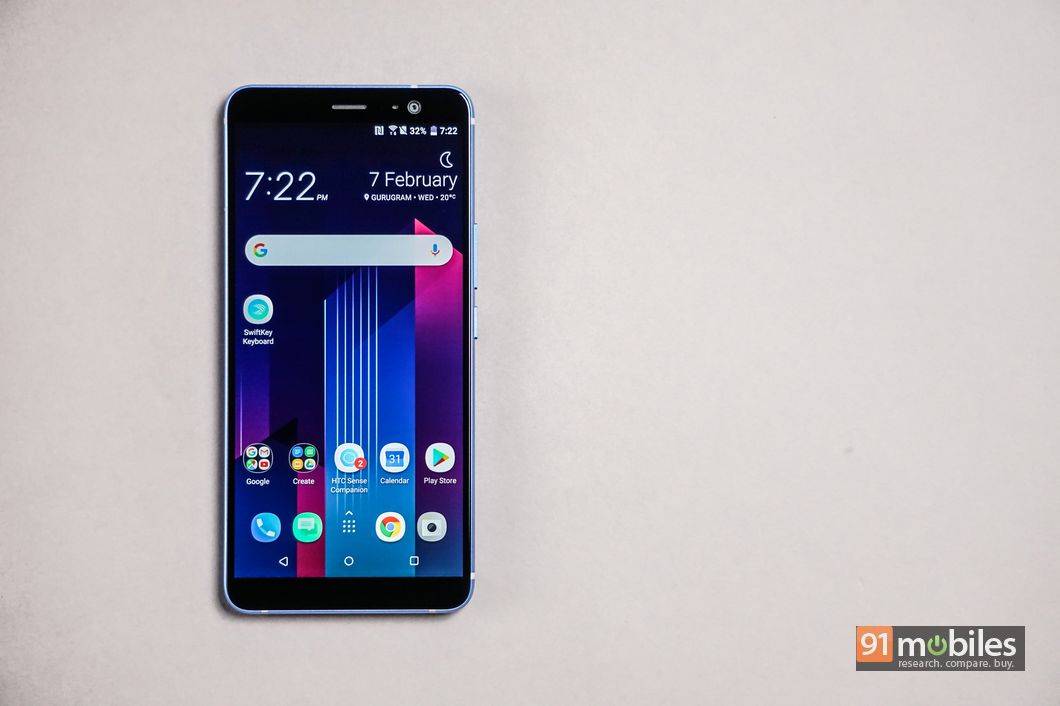
“The U11+ is the brand’s first smartphone with an 18:9 display”
After introducing the U11 (review) in May globally, the Taiwanese brand HTC unveiled its siblings in November – the U11+ and U11 Life. While the U11 was released in India in June, now the company is bringing its Plus variant to the Indian subcontinent. Priced at Rs 56,990, the device adds modern features like a tall 18:9 display to the U11. What else does it offer and is it really a big upgrade to the U11? Let’s find all that and more in our unboxing and initial impressions.
The HTC U11+ will grab your attention as soon as you lay our eyes on it. Continuing with its glossy glass design, the smartphone looks extremely premium, even in the shiny blue hue. In comparison to the U11, the Plus sibling is just a taller device that has shed a significant bezels on the fascia. This ensures that the smartphone isn’t too big, even though it has gained 0.5-inches on its screen (compared to the 5.5-inch panel on the U11). On the flip side however, the mirror finish doesn’t offer firm grip and attracts smudges like a moth to a flame.

HTC has already followed Apple’s footsteps, and the U11+ is no different. The phone doesn’t offer a 3.5mm audio interface, but the retail package does come with a pair of USonic headphones with a Type-C connector, as well as a dongle allowing you to use regular earphones. Talking about other contents of the box, you get some documentation, a wall charger and a USB Type-C cable along with a SIM-ejection tool. Thankfully, the smartphone also comes bundled with a transparent cover.
One noticeable difference between the HTC U11 and U11+ in terms of the design is the placement of fingerprint sensor… since the latter has a bezel-less display, the biometric authentication sensor has been moved around to the back. The positioning of ports and controls remain the same however.
The display resolution continues to be QHD, but with an aspect ratio of 18:9. The Super LCD 6 screen offers crisp visuals and reproduces accurate colours. Brightness levels are also impressive, and so are the viewing angles. Acting as a safeguard against scratches and minor knocks is a layer of Corning Gorilla Glass 5.
Physical differences aside, the HTC U11+ is exactly same as the U11 in terms of internals and cameras. The smartphone utilises the high-end octa-core Qualcomm Snapdragon 835 processor which is coupled with 6GB of RAM. The U11 was a delight to use and we believe that its bigger brother should also offer similar performance. Of course, we’ll be discussing it in-depth in our review, so stay tuned. On the storage side of things, the U11 Plus ships with 128GB memory onboard.
On the camera front, the U11+ doesn’t go the dual-camera route and sports a 12-megapixel UltraPixel 3 camera at the back with f/1.7 aperture and a dual-tone LED flash. For selfies, it has an 8MP snapper.
The HTC U11+ is among the very few flagships that boot the latest iteration of Android, viz. 8.0 Oreo. Skinned with the proprietary Sense UI, the device features a custom interface, but doesn’t come with much bloatware. You do get Edge Sense however, which lets you initiate various actions or open apps by squeezing the sides of the phone.
With the increase in size, the U11 Plus also gets a beefier 3,930mAh battery. This should see the device lasting more than a day and then some more with ease. With support for Quick Charging 3.0, it can be juiced up quickly.

HTC’s U11 was an impressive flagship of 2017, and the the U11+ does bring some much-needed improvements like a bezel-less design. It must be noted that the flagship battle of 2018 is yet to start… with biggies like Samsung, Sony and Huawei due to unveil their own flagships very soon. Not to mention that affordable flagships will also continue to offer strong competition by bringing powerful specs at lower prices. The HTC U11+ has been priced at Rs Rs 56,990, and is looking like a compelling, if pricey option at the moment. We’re looking forward to testing it out extensively to see how it fares.
Photos by Raj Rout























